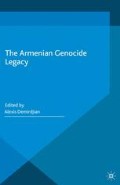Abstract
The Ottoman Empire’s massacre of Armenians in 1915–16 is one of the early genocides of the 20th century.2 Suggestions about how to provide legal accountability to the Armenians range from the filing of lawsuits in municipal courts,3 to the establishment of a claims process similar to that for victims of the Nazi Holocaust,4 to the creation of a truth and reconciliation commission like that established in South Africa to address apartheid.5
Associate Dean for International and Comparative Legal Studies, George Washington University Law School. Thanks to Luke Wilson for comments and suggestions.
Access this chapter
Tax calculation will be finalised at checkout
Purchases are for personal use only
Preview
Unable to display preview. Download preview PDF.
Notes
For example, M. J. Bazyler (2011) ‘From Lamentation and Liturgy to Litigation: The Holocaust-Era Restitution Movement as a Model for Bringing Armenian Genocide-Era Restitution Suits in American Courts’, Marquette Law Review, Vol. 95 (1): 245.
V. Saroyan (2011) ‘A Lesson from the Holocaust Restitution Movement for Armenians: Generate Momentum to Secure Restitution’, Cardozo Journal of Conflict Resolution, Vol. 13 (1): 285. See also Chapter 6, Guibert and Kim.
J. Shamsey (2002) ‘80 Years Too Late: The International Criminal Court and the 20th-Century’s First Genocide’, Journal of Transnational Law & Policy, Vol. 11(2): 327, 378–81.
A. Kuyumjian (2011) ‘The Armenian Genocide: International Legal and Political Avenues for Turkey’s Responsibility’, Revue de Droit Université de Sherbrooke, Vol. 41(2): 247, 280–7.
The ICJ is constrained as to fact-finding, particularly on the requisite intent for genocide. See D. Groome (2007) ‘Adjudicating Genocide: Is the International Court of Justice Capable of Judging State Criminal Responsibility?’, Fordham International Law Journal, Vol. 31 (4): 911, 979.
P. Dunberry (2014) ‘The Consequences of Turkey Being the “Continuing” State of the Ottoman Empire in Terms of International Responsibility for Internationally Wrongful Acts’, International Criminal Law Review, Vol. 14 (2): 261.
Akçam (2012), pp. 228–85; R. Kévorkian (2011) The Armenian Genocide: A Complete History ( London: I. B. Tauris);
U. Ü. Üngör and M. Polatel (2011) Confiscation and Destruction: The Young Turk Seizure of Armenian Property ( London and New York: Continuum).
V. N. Dadrian and T. Akçam (2011) Judgment at Istanbul: The Armenian Genocide Trials ( New York and Oxford: Berghahn Books ), pp. 13, and 18 (quoting Interior Ministry Archives, D.H. Cipher Office, SFR File 54.426, 13 July 1915 report).
For example, see V. N. Dadrian (2004) ‘The Armenian Genocide: An Interpretation’, in J. Winter (ed.) America and the Armenian Genocide of 1915 ( Cambridge: Cambridge University Press ), pp. 52–100.
E. Schwelb (1946) ‘Crimes against Humanity’, British Yearbook of International Law, XXIII, pp. 178, and 181. See also Chapter 10, Chorbajian, for the Allied Powers’ telegram of 29 May 1915.
T. Akçam (1999) ‘The Genocide of the Armenians and The Silence of the Turks’, in L. Chorbajian and G. Shirinian (eds), Studies in Comparative Genocide ( New York: St Martin’s Press ), pp. 125, and 143.
B. Algan (2008) ‘The Brand New Version of Article 301 of Turkish Penal Code and the Future of Freedom of Expression Cases in Turkey’, German Law Journal, Vol. 9 (12): 2237–45.
P. Gaeta (2007) ‘On What Conditions Can a State Be Held Responsible for Genocide?’, European Journal of International Law, Vol. 18 (4): 631–48, (631, 642).
W. A. Schabas (2006) The UN International Criminal Tribunals: Former Yugoslavia, Rwanda and Sierra Leone ( Cambridge: Cambridge University Press ), p. 161.
C. J. Tams, L. Berster and B. Schiffbauer (2014) Convention on the Prevention and Punishment of the Crime of Genocide: A Commentary (Munich: C. H. Beck, Hart Publishing & Nomos ), p. 56.
B. Simma (2013) ‘Human Rights before the International Court of Justice: Community Interest Coming to Life?’, in J. Sloan and C. J. Tams (eds) The Development of International Law by the International Court of Justice ( Oxford: Oxford University Press ), pp. 301, and 319.
J. Alvarez (2007) ‘Burdens Of Proof–Notes from the President’, American Society of International Law Newsletter, No. 23: 1.
M. Milanović (2007) ‘State Responsibility for Genocide: A Follow-Up’, European Journal of International Law, Vol. 17 (3): 669, 678.
See S. Power (2002) A Problem from Hell: America and the Age of the Genocide ( New York: Basic Books ), pp. 51–65.
R. Kolb (2009) ‘The Scope Ratione Materiae of the Compulsory Jurisdiction of the ICJ’, in P. Gaeta (ed.) The UN Genocide Convention: A Commentary ( Oxford: Oxford University Press ), pp. 442, and 464.
A. de Zayas (2004) The Genocide against the Armenians 1915–1923 and the Relevance of the 1948 Genocide Convention, http://alfreddezayas.com/Law_history/armlegopi.shtml.
C. Fournet (2007) The Crime of Destruction and the Law of Genocide ( Aldershot, UK: Ashgate ), pp. 83–4.
S. L. Karamanian (2013) ‘Economic-Legal Aspects of the Armenian Genocide’, International Criminal Law Review, Vol. 14 (2): 242–60 (242 and 256–7).
Author information
Authors and Affiliations
Editor information
Editors and Affiliations
Copyright information
© 2016 Susan L. Karamanian
About this chapter
Cite this chapter
Karamanian, S.L. (2016). The International Court of Justice and the Armenian Genocide. In: Demirdjian, A. (eds) The Armenian Genocide Legacy. Palgrave Studies in the History of Genocide. Palgrave Macmillan, London. https://doi.org/10.1007/978-1-137-56163-3_6
Download citation
DOI: https://doi.org/10.1007/978-1-137-56163-3_6
Publisher Name: Palgrave Macmillan, London
Print ISBN: 978-1-349-57402-5
Online ISBN: 978-1-137-56163-3
eBook Packages: HistoryHistory (R0)

